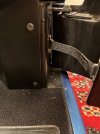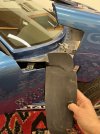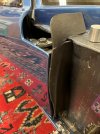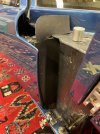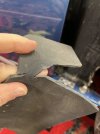On the RCR40 - Has anyone come up with a good method for sealing out road debris from the gap at the door hinge? I was ending up with a lot of gravel and dirt flying in so ended up cutting out this shape from a 1/8" thick piece of neoprene rubber that filled the entire gap including the bit at the top under the curve of the hood which also leaves an opening right into the cockpit. It worked well for a while until repeated opening and closing of the door started to tear and split the rubber and the dirt is coming back in again. I was considering using some kind of closed cell EVA foam that wouldn't attract and retain moisture but concerned that might be too rigid and interfere with the door movement. What have you guys come up with?
Also, how about the strip along the bottom edge of the door where daylight shows along the full length? I could mount a gasket on the door sill but that would disrupt the smooth look of the sill and interfere sliding into to the car. Alternatively, leaving a gasket hanging down on the bottom inside edge of the door doesn't look attractive either. Any thoughts?
Also, how about the strip along the bottom edge of the door where daylight shows along the full length? I could mount a gasket on the door sill but that would disrupt the smooth look of the sill and interfere sliding into to the car. Alternatively, leaving a gasket hanging down on the bottom inside edge of the door doesn't look attractive either. Any thoughts?


